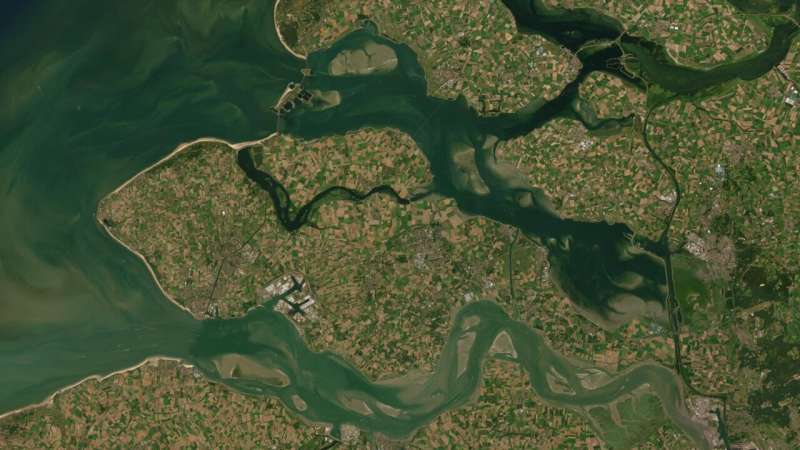
To preserve the important intertidal areas and salt marshes off our coasts for the future, we need more turbid water. That is one of the striking conclusions from a new study conducted by a Dutch-Chinese team of researchers and published in Nature Geoscience.
“These natural areas outside our dikes are essential for nature and coastal defense. But because how we are now building in the Delta and the hinterland, coastal defense is endangered in the long term,” warns NIOZ researcher Tim Grandjean.
For his research, Grandjean linked decades of satellite measurements of tidal areas around the world with data on the turbidity of the water, which is also measured by satellites. Importantly, Grandjean has established a lower limit for the necessary turbidity of the water in deltas worldwide. A very clear relationship emerged in the long term: intertidal areas only grow when the water is turbid enough. “After all, turbid water means more sand and silt particles in the water, which can allow the coast to grow,” the researcher explains.
Worldwide, the turbidity of many coastal waters has been declining for decades, making the tidal flats sensitive to loss. Additionally, sea level rise requires that water has higher turbidity to continue to maintain tidal flats. The relatively low turbidity globally threatens essential areas for biodiversity and coastal safety. After all, tidal flats are important foraging areas for birds and contribute to wave attenuation.
Coastal defenses must improve
Globally, the determination of the necessary turbidity for the preservation of tidal flats by Grandjean provides an essential basis for rethinking human interventions in deltas. We need to think more carefully about the ways in which human activities affect the coast, on which we rely for our safety.
These challenges are not unique to any one region but are evident globally due to extensive human modifications to natural water systems. For instance, the construction of large dams, such as the Three Gorges Dam on the Yangtze River, has significantly reduced the sediment supply downstream. This reduction is crucial for the propagation of tidal flats, leading to sediment starvation that hinders the natural rebuilding of intertidal zones, vital for coastal protection and biodiversity.
Similarly, in the Netherlands, the construction of the storm surge barrier in the Oosterschelde in the 1980s has led to severe “sand starvation.” Because of this barrier, less sand can flow from the North Sea into the estuary, resulting in clearer water that fails to replenish the intertidal areas, thus causing them to erode.
“In the long run, this is not sustainable,” Grandjean says.
“When too much intertidal area disappears outside the dikes of Zeeland, the safety of the complete coast is at stake. So not only for nature, but also for safety, we must begin to protect the areas outside the dikes much more effectively. The water has to become murkier, so we may have to consider dismantling the Oosterschelde storm surge barrier in the future. A careful balance between nature conservation and coastal protection is essential, ensuring that both goals strengthen rather than counteract each other.”
Tim Grandjean defended his Ph.D. on this topic on April 24 and has also collected new data on the dynamics of intertidal areas. These data provide insight into the short-term vulnerability. He used a technique that was developed in NIOZ workshops.
“The dynamics of intertidal areas can be measured with very expensive sensors or with labor-intensive, manual measurements. However, this way, we could never collect data in many different places at the same time. The technicians at NIOZ developed sensors that were cheap enough to record the height of the bottom to the millimeter, several times a day, at different locations along the Western and Eastern Scheldt for several years now.”
Those precise measurements show that at high tide, an intertidal zone can easily vary one or two centimeters in height within a single day. “For you or me, a centimeter more or less under our boots may not matter, but if you are a worm or a mussel, or a seed of eelgrass, that is indeed too much dynamics,” Grandjean says.
Grandjean also looked at the grounds between groins constructed by the province of Zeeland, to improve the quality of tidal nature along part of the banks of the Westerschelde.
“Of course, we already knew that these groins, along rivers and coasts, can protect, but our measurements show that benthic life along the Westerschelde also benefits from these measures. The dynamics decrease enough in time and space for benthic animals to settle better.”
Additionally, the reduction in flow between the groins could potentially benefit the stability of the intertidal coastal areas in the long term and mitigate the effects of rising sea levels. However, further research is essential for understanding this dynamic and its long-term effects.
More information:
Tim J. Grandjean et al, Critical turbidity thresholds for maintenance of estuarine tidal flats worldwide, Nature Geoscience (2024). DOI: 10.1038/s41561-024-01431-3
Journal information:
Nature Geoscience
Provided by
Royal Netherlands Institute for Sea Research
Turbid waters keep the coast healthy, finds study (2024, May 6)
retrieved 7 May 2024
from https://phys.org/news/2024-05-turbid-coast-healthy.html
part may be reproduced without the written permission. The content is provided for information purposes only.